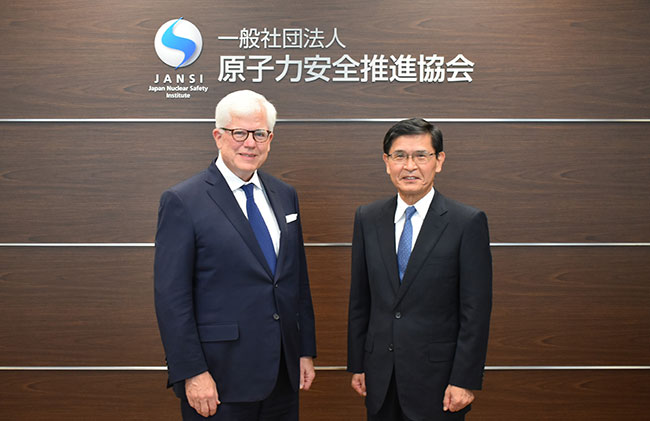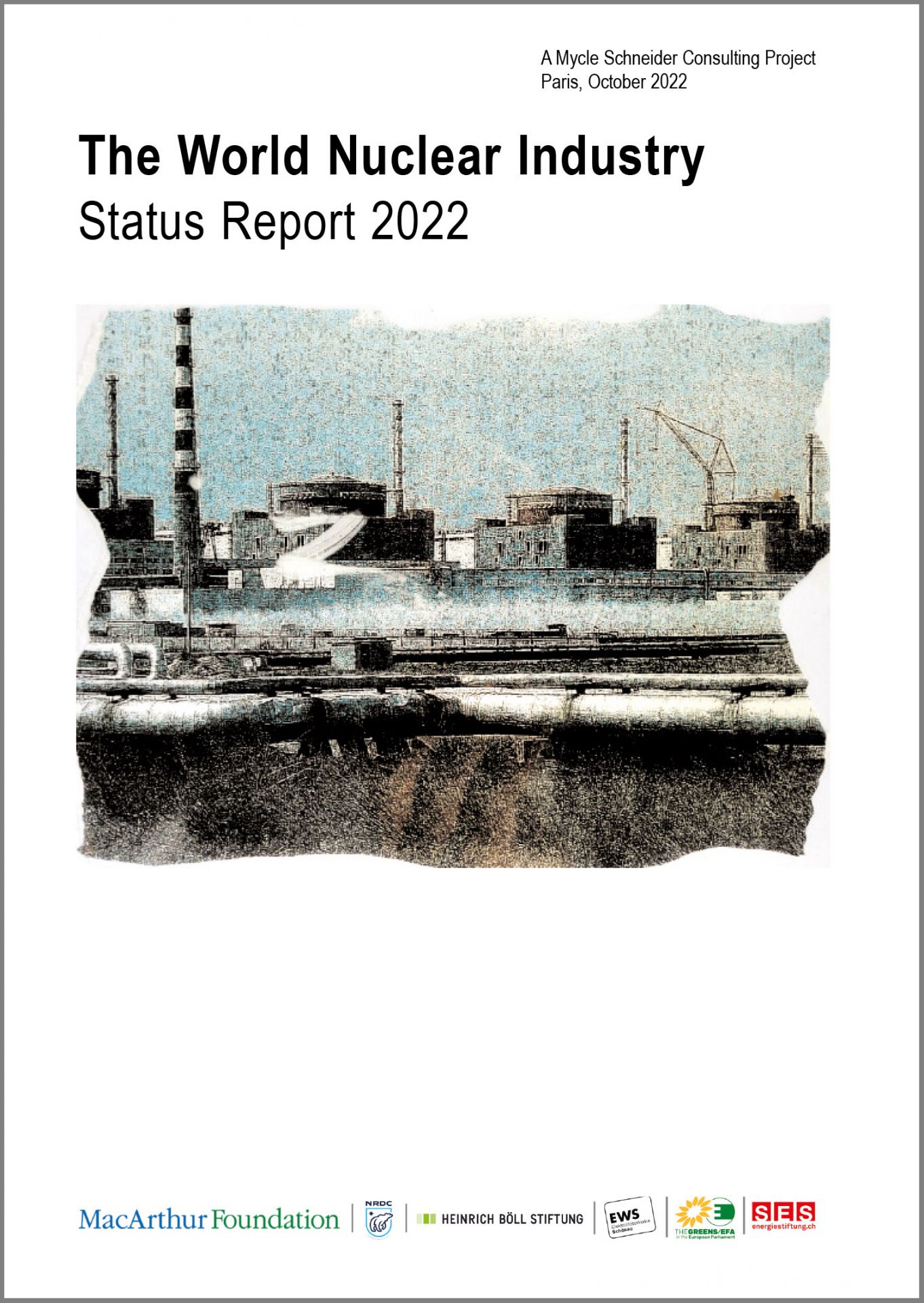Diagram of the University of Rochester Laboratory for Laser Energetics’ OMEGA laser system. (Image: University of Rochester)
A study recently published in Nature Communications brings a new perspective on how radiation travels through dense plasmas, potentially leading to a better understanding of the evolution of stars and the development of controlled nuclear fusion reactions. Researchers led by investigators at the University of Rochester Laboratory for Laser Energetics (LLE) achieved their findings by conducting experiments with LLE’s OMEGA laser system. This extensive system, which is 19 meters tall and 70 meters long, consists of 60 laser beams that can focus as much as 30,000 joules of energy onto a target for the study of nuclear and fluid dynamic events.
JANSI’s chairman William Edward Webster Jr. (left), and president and CEO Hiromi Yamazaki. (Photo: JANSI)
The Japan Nuclear Safety Institute (JANSI) marked its 10th anniversary on November 15 by publishing a letter that highlighted some of the organization’s greatest accomplishments of the past decade. In the letter, William Edward Webster Jr., chairman of the JANSI board of directors, and Hiromi Yamazaki, JANSI president and chief executive officer, expressed their “sincere gratitude to all our members and other stakeholders who have provided support and guidance over the past 10 years.”
The TRIGA Mark II nuclear research reactor. (Photo: University of Texas)
The Nuclear Regulatory Commission has conducted a special inspection at the University of Texas’s TRIGA Mark II nuclear research reactor in Austin to evaluate the use of improper fuel. The inspection was ordered following a notification from the University of Texas—Austin to the NRC that the research reactor had been operating for several months with two fuel elements that were not licensed for the reactor.
The molten salt test loop at ACU’s NEXT Lab. (Photo: Jeremy Enlow/SteelShutter)
The Nuclear Regulatory Commission has announced that it will review a construction permit submitted by the Nuclear Energy eXperimental Testing (NEXT) Laboratory at Abilene Christian University for the lab’s planned molten salt research reactor (MSRR). The NRC informed Rusty Towell, director of the NEXT Lab and professor in ACU’s Department of Engineering and Physics, about its acceptance of the construction permit review in a November 18 letter. The NEXT Lab had submitted the construction permit application on August 15; it was the first-ever university application for an advanced research reactor. On October 14, they provided the NRC with additional information about instrumentation and controls. (Nuclear News featured an article about the NEXT Lab and the MSRR in the November issue.)
Scheduled to appear at the Energy Security panel session at COP27: from left, moderator Sweta Chakraborty and speakers Kathryn Huff, Seth Grae, and Bonnie Jenkins.
The United Nations’ COP27 conference, held this year in Sharm el-Sheikh, Egypt, from November 6 to 18, will feature the panel discussion “Energy Security” on Tuesday, November 15, at 9:00 a.m. EST (4:00 p.m. local time). The discussion is being sponsored by the review platform We Don’t Have Time; the live stream will be available to viewers on their COP27 Climate Hub website.
The USS Rickover (SSN 795). (Photo: USS Hyman G. Rickover Commissioning Committee)
NBC Chicago featured a story last week about a visit to the Windy City by the commander and crew of the USS Hyman G. Rickover (SSN-795), the navy’s newest nuclear submarine. The submarine was christened in July 2021 and is currently undergoing trials out of Naval Submarine Base New London in Groton, Conn., before its expected commissioning in 2023. Reporter Charlie Wojciechowski described the sailors’ meetings with students from Chicago’s Rickover Naval Academy, along with the sailors’ visits to the Museum of Science and Industry and other city landmarks. He also interviewed Commander Matthew H. Beach.
Sesuvium portulacastrum (Photo: David Eickhoff/Wikicommoms)
The authors of a study that was recently published in Advances in Agriculture have recommended that the plant Sesuvium portulacastrum, commonly known as sea purslane, “be cultivated in [cesium]-contaminated soils and near nuclear power plants for phytoremediation.” The researchers found that S. portulacastrum is a “hyper-accumulator” of radioactive cesium isotopes, which are byproducts of nuclear fission reactions in nuclear reactors. The study results suggested that these plants could efficiently remove the toxic metallic chemicals from contaminated soil around nuclear facilities.
Then energy secretary Bill Richardson decided to permanently shut down the HFBR in November 1999. (Photo: DOE)
“Why did a tiny leak bring down a hugely successful research reactor 25 years ago?”
That’s how Robert P. Crease, an academic who writes a regular column for Physics World, introduces The Leak: Politics, Activists, and Loss of Trust at Brookhaven National Laboratory, a book he wrote with former interim BNL director Peter D. Bond that was published this month by MIT Press.
“Were this story fiction, its characters, plot twists and ironies would be entertaining,” Crease writes in his October 5 Physics World post about the book. “But because it’s fact, it’s a tragicomedy.”







 Nuclear energy “has exceptional characteristics that make it uniquely qualified to address all three facets of the energy trilemma: affordability, sustainability, and reliability,” according to a new report,
Nuclear energy “has exceptional characteristics that make it uniquely qualified to address all three facets of the energy trilemma: affordability, sustainability, and reliability,” according to a new report, 


.jpg)






 A picture of the state of the global nuclear energy industry has been painted in a
A picture of the state of the global nuclear energy industry has been painted in a 